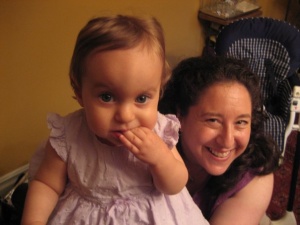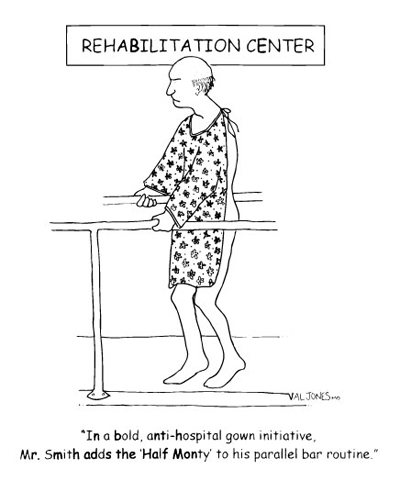June 23rd, 2009 by Jerome Ecker, M.D. in Better Health Network, Health Tips
No Comments »

Cardiac rehabilitation, or guided exercise under direction of a physical therapist, is a valuable yet underutilized therapy for patients suffering a heart attack. Importantly, in those patients with ongoing risk factors related to obesity and insulin resistance/diabetes, aggressive cardiac rehab was recently shown to be especially effective.
Specifically, two groups of patients were enrolled in high intesity (5-7 days weekly of 45-60 minutes exercise) versus standard (3 days weekly of 25-40 minutes exercise).
High intensity patients lost more than twice as much weight over 5 months as standard patients (18 pounds vs. 8 pounds and had significantly greater reductions in 2 major cardiac risk factors — waist circumference and insulin resistance. At 1 year, both groups had gained a couple of pounds over 5-month weights, but total body-fat percentages in the aggressive group remained significantly lower than initial readings. Other cardiac risk factors changed too – including decreased insulin resistance, increased HDL (good) cholesterol, and decreased measures of insulin, triglycerides, blood pressure, plasminogen activator inhibitor-1, and the ratio of total to HDL (good) cholesterol.
Overall then, patients who took advantage of their motivation after heart attack to aggressively address exercise goals reduced potential risk factors and set the tone for a healthier life. If you have been a heart attack sufferer, ask your doctor about cardiac rehab. If you are not a heart attack sufferer but have risks, ask your doctor about trying a program like this on your own.
Questions and comments welcome as always!
*This blog post was originally published at eDocAmerica*
April 22nd, 2009 by Medgadget in Better Health Network
1 Comment »
 A five year old British girl who had her outer limbs amputated due to meningitis (meningococcemia with meningitis accompanied by gangrene of the extremities would be our guess) has received a new pair of legs.
A five year old British girl who had her outer limbs amputated due to meningitis (meningococcemia with meningitis accompanied by gangrene of the extremities would be our guess) has received a new pair of legs.
The high tech carbon fiber pair is of the variety commonly seen on competitive Special Olympics athletes, some of whom run faster than old fashion legged people. Ellie’s parents say that she already walks twice as fast as her previous conventional prosthetic pair.
We believe that medical devices will greatly improve Ellie’s life in the future, and hopefully she can one day receive a proper pair of Deka arms.
More from Echo UK…
(hat tip: Gizmodo)
*This post was originally published at Medgadget.com*
October 17th, 2008 by Dr. Val Jones in Patient Interviews
No Comments »

Deanna and Rebecca Sherman
As many as 15% of Americans have a blood disorder (called anti-phospholipid antibody syndrome – APS) that can increase their risk for blood clots and stroke. While these antibodies are especially common in people with certain auto-immune diseases like SLE (systemic lupus erethematosis – or “lupus”) quite a few people have them without ever knowing it. In fact, most people with APS remain asymptomatic their entire lives – but for an unlucky few, the disorder can cause devastating consequences.
I interviewed Rebecca Sherman about her recent stroke caused by APS. Listen to the podcast here.
Dr. Val: Tell me about the events leading up to your stroke.
Sherman: I was a young, healthy 32-year-old with no idea that I had anti-phospholipid antibodies in my blood. One morning when I was washing my face at my boyfriend’s house I suddenly noticed that one side of it was frozen. I was standing in front of the bathroom sink and I fell to the floor with the washcloth in my hand. I couldn’t walk or talk – the whole right side of my body didn’t do what I wanted it to do. So I threw the washcloth at my boyfriend’s head (with my left hand). Luckily my aim was good (he was asleep in bed) and the bed was near the door to the bathroom – the cold, wet object caused him to jump out of bed and find me. Read more »
May 15th, 2008 by Dr. Val Jones in True Stories
No Comments »
I spent my senior year of college abroad in Scotland. Between the fall and spring semesters I went on a ski trip to Austria, and in usual Val fashion did something klutzy out of enthusiasm. I was racing down a slalom course in a snow storm and was so excited to have finished without missing a wicket that I looked up at some bystanders to give them a thumb’s up and I tripped on a clump of snow and fell down. Unfortunately my binding didn’t release and I ripped some ligaments off my knee. I heard them pop too. It was quite gross.
Anyway, I was shipped back to Canada for a complex ACL repair procedure by the Olympic Ski Team’s surgeon (I was NOT Olympic material in case any of you had the slightest doubt – I was just in the right hospital at the right time). What followed my fine surgery was a not so fine follow up – in fact I didn’t get any physical therapy whatsoever, and had no idea about how to make my knee functional again. All I knew is that it hurt like heck and I didn’t want to move it. And I pretty much didn’t. Not for a month or so.
Now the healthcare professionals in the audience just winced at that. Not moving a limb for a month is highly inadvisable. My knee became contracted so that I couldn’t straighten it at all. I could barely bear weight on it and I relied almost solely on crutches. I didn’t know how long knees were supposed to take to heal so I figured everyone went through this crutch phase for months.
I returned to Scotland for my spring semester, and I can tell you that traveling alone with one functional leg, a pair of crutches, winter gear and two suitcases is no piece of cake. But the most memorable part of this whole debacle was when I received my new dorm room assignment: the room was on the 5th floor – no elevators. I pleaded with the dorm warden (a humorless, underweight Scottish man with extraordinarily greasy hair and snaggle teeth) to have pity on me and reassign me to a room on the first floor or maybe the second. He handed me the 5th floor room keys unflinchingly.
So it took me about an hour to drag myself and all my stuff up to the 5th floor. I was really in a lot of pain, and totally exhausted from the multi-stop flight overseas – hadn’t slept in about 36 hours. Of course the room was the last one at the end of the hall and no other students had checked in yet – the whole place was deserted because I’d come back early to see if I could get a more conveniently located room (thinking ahead).
When I got to my room I was nearly overwhelmed by the smell of vomit. Apparently the winter session kids had been using my dorm room for drunken partying and had puked on the mattress. I was so tired all I wanted to do was go to sleep but the options were the cement floor or the pukey mattress so I called down to the front desk. The warden picked up – I really couldn’t understand much of what he said in his thick brogue. I explained to him that I’d made it to my room but that the mattress was covered in vomit and I wondered if (now) I might be eligible for a different room. He said he’d come up to check on the mattress.
It took him about 40 minutes to show up. He made no eye contact with me as I limped after him into the room to show him the vomit. He looked at the mattress, smiled wryly, dragged it to the edge of the bed frame and flipped it over. Then he walked out of the room and went back down the stairs to retake his post at the front desk at the entrance to the building.
Now that’s cold.This post originally appeared on Dr. Val’s blog at RevolutionHealth.com.



 A five year old British girl who had her outer limbs amputated due to meningitis (meningococcemia with meningitis accompanied by gangrene of the extremities would be our guess) has received a new pair of legs.
A five year old British girl who had her outer limbs amputated due to meningitis (meningococcemia with meningitis accompanied by gangrene of the extremities would be our guess) has received a new pair of legs.









